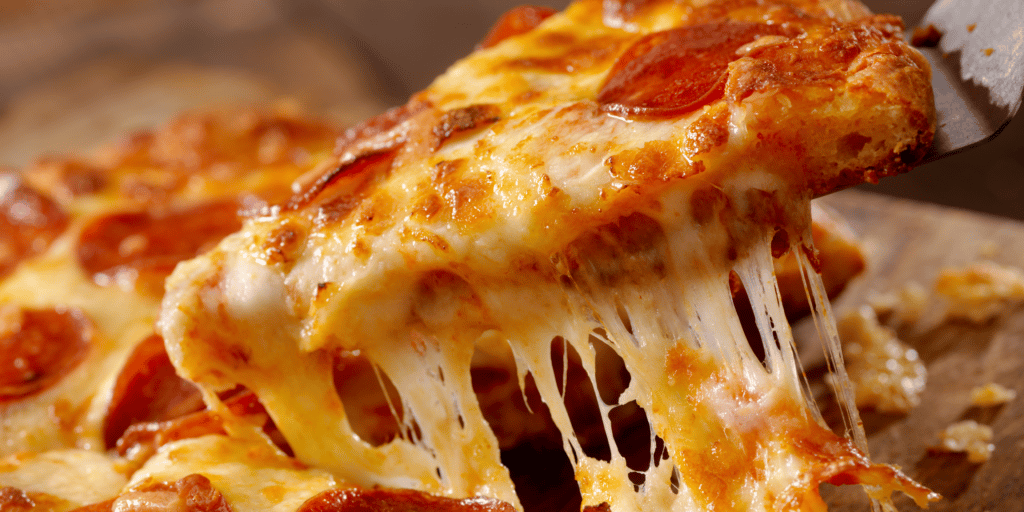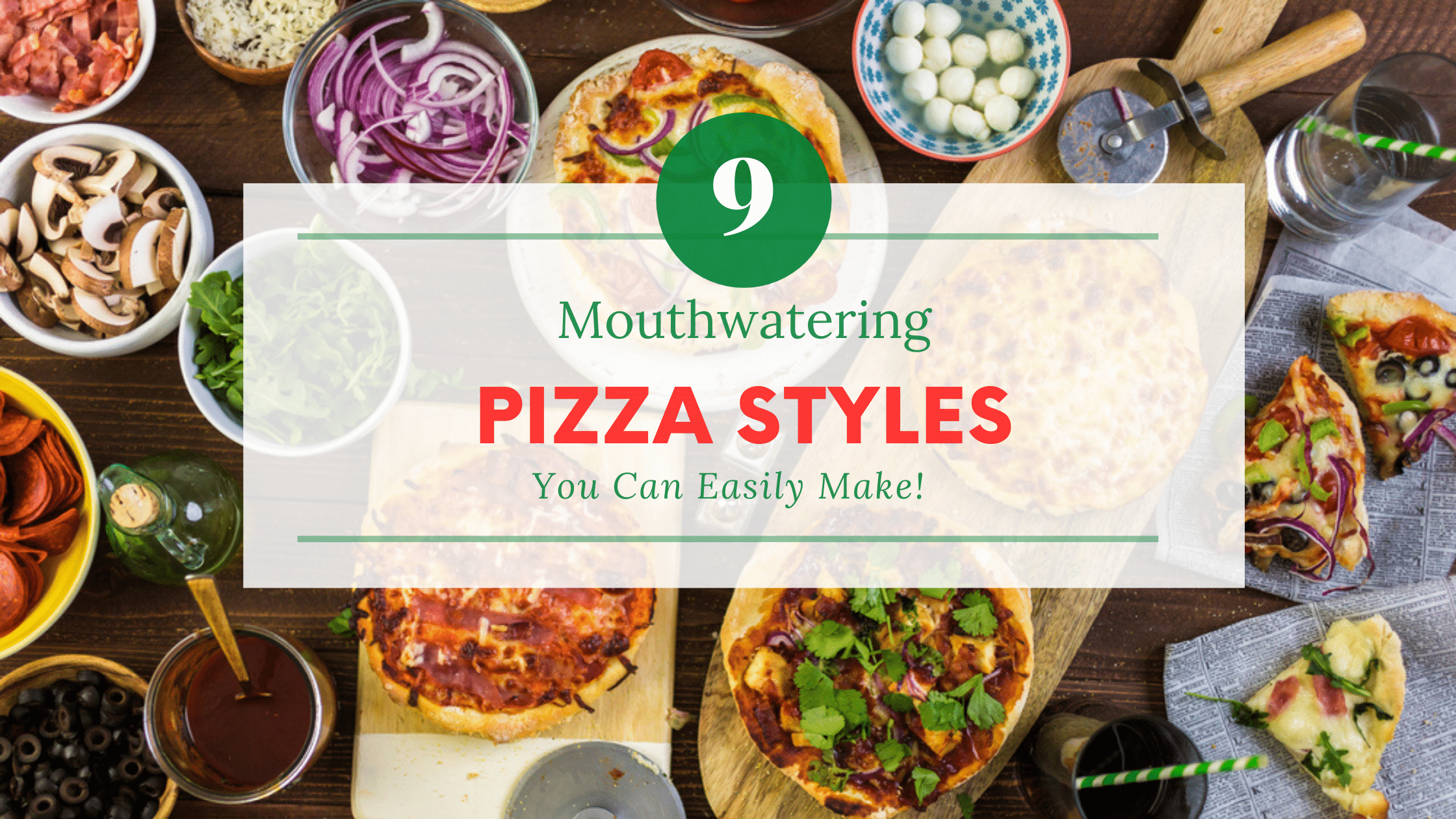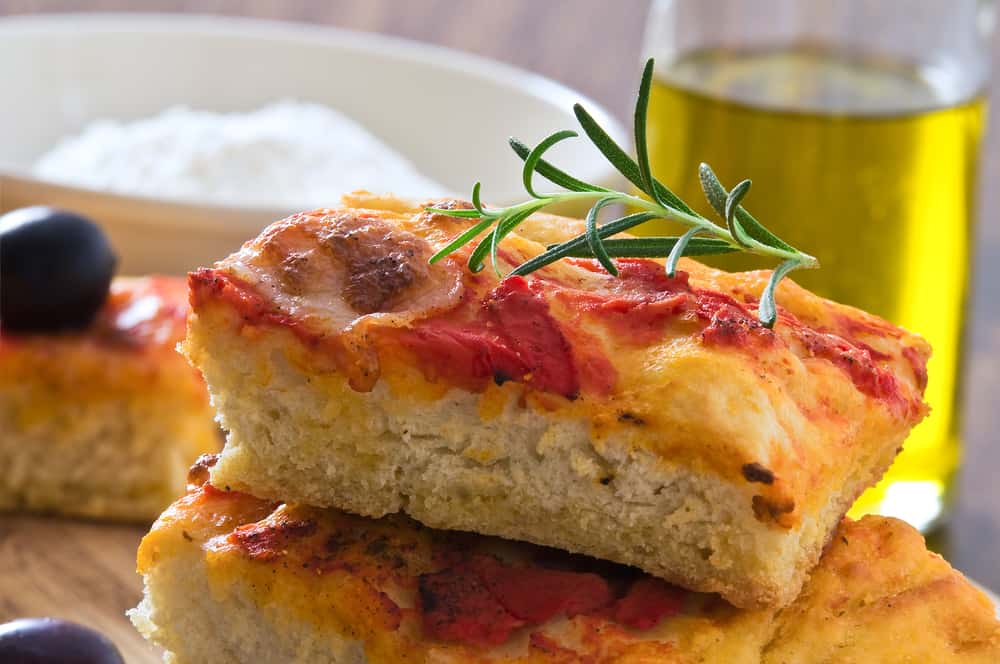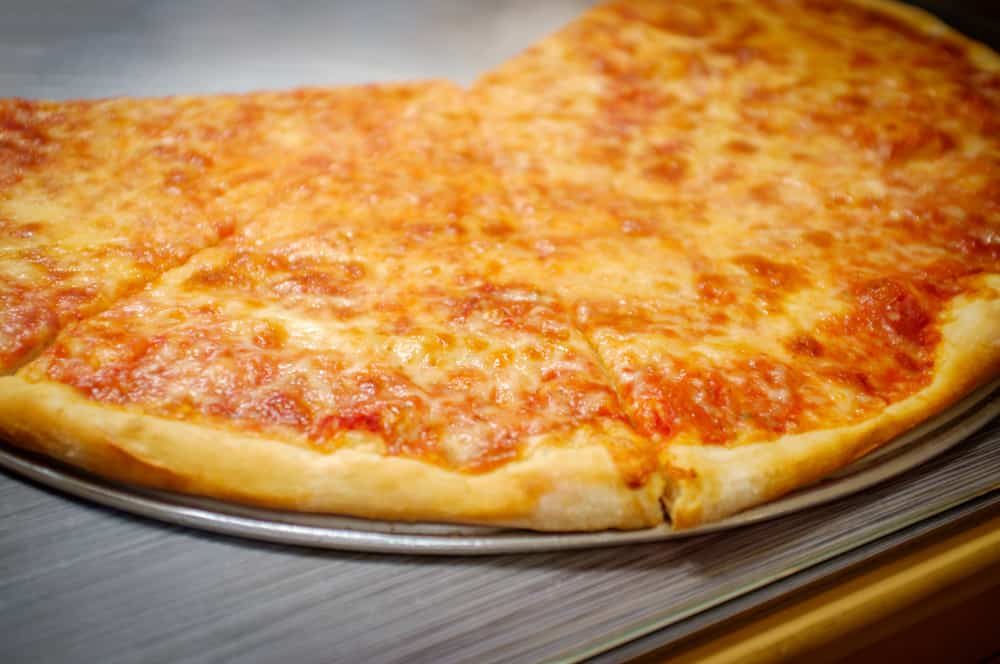What is Brooklyn Style Pizza? This query is more than just a question about a pizza style. It’s an invitation to delve into a rich culinary history and understand a delectable variation that has claimed a special spot in pizza aficionados’ hearts.
Defined by its thin, crisp, yet slightly chewy base, large foldable slices, and a balance of flavors, Brooklyn style pizza is a gastronomic journey to be savored.
We’ll explore the defining features and origins of this irresistible pizza style, take a virtual stroll through some renowned Brooklyn pizzerias, and give ambitious home chefs a handy guide to crafting their own Brooklyn style pizza.
So, pizza PROs, prepare for a flavorful exploration into the captivating world of Brooklyn style pizza – a journey that promises to bring a slice of Brooklyn into your kitchen!
Let’s check it out!
Here’s What You Will Find:
Key Takeaways
What is Brooklyn Style Pizza?
Brooklyn Style Pizza is known for its thin, large, and foldable slices, offering a distinctive balance between a crispy and slightly chewy crust.
This pizza style originated as an adaptation of Neapolitan pizza, evolving to suit the tastes and ingredients available in New York.
Brooklyn pizzerias, such as Grimaldi’s and Di Fara Pizza, have played a crucial role in popularizing this pizza style, with their commitment to quality, authenticity, and innovative toppings.
You can create your own Brooklyn Style Pizza at home with high-gluten bread flour, a hot oven, and a judicious selection of toppings, embracing the less-is-more approach characteristic of this pizza style.
What is Brooklyn Style Pizza?
Brooklyn style pizza is a unique type of pizza characterized by large, thin, and crispy yet slightly chewy slices that are traditionally hand-tossed and foldable, often topped with classic, minimal ingredients to let the flavor of the high-gluten dough, mildly sweet sauce, and perfectly melted cheese truly stand out.
Brooklyn style pizza is a unique pizza variant that originated from the cultural melting pot of New York City. Named after the borough of Brooklyn, where its popularity initially soared, this style has become a beloved staple in pizzerias across America and the world.
Characteristics of the Brooklyn-Style Pizza
The beauty of Brooklyn style pizza lies in its simplicity yet distinct characteristics. It features large, thin slices that are both crispy and slightly chewy, providing a delightful contrast in texture. This thinness makes the slices foldable, a signature trait of Brooklyn style pizza.
The crust is traditionally hand-tossed, contributing to the characteristic lightness and airiness, and it is often baked to a perfect golden brown. Toppings are typically classic and minimal, allowing the flavor of the high-gluten dough, the mildly sweet sauce, and the perfectly melted cheese to shine through.
However, variations are abundant, and one can find Brooklyn style pizzas adorned with a diverse range of toppings, showcasing the adaptability of this style to modern tastes.
While its large size, foldability, and thin-crust may seem simple enough, each of these elements holds a story of cultural integration, culinary innovation, and the timeless pursuit of flavor. In the following sections, we’ll delve deeper into these aspects, tracing the journey of this pizza style from its inception to the iconic status it holds today.
Brooklyn style, which has a hand-tossed final form of dough decorated with grated mozzarella and gently layered with a tomato-based sauce, has grown and progressed from the traditional New York style of pizza.
Today, Brooklyn-style pizza is one of America’s most well-known pizza styles. It is also renowned for being incredibly crispy and thin.
Overall, a Brooklyn-style pizza’s crust sets it apart from other types of pizza. Compared to the regular thick, sticky crust that many people are used to, this one has a crispier and lighter feel.

Brooklyn-style pizzas also tend to have a well-done crust with a little additional sauce and a drizzle of olive oil rather than a thick layer of cheese or large chunks of meat and vegetables.
However, note that a Brooklyn-Style Pizza’s thin, crisp, and malleable crust is essential. In addition, this pizza can be bent and folded in half while you eat.
Pizzas cooked in the Brooklyn style are usually cut into six slices. However, other thick-dough pizzas are cut into 8 or 16 triangular slices.
These pizzas also generally include both mozzarella and provolone.
In addition, Brooklyn-style pizzas are cut into squares rather than triangles since they have a thin crust and are more likely to break.
Origin and History of Brooklyn Style Pizza
How Brooklyn Style Pizza Came to Be?
The story of Brooklyn style pizza begins with the wave of Italian immigrants that arrived in New York City in the late 19th and early 20th centuries.
These new residents brought with them their rich culinary traditions, including the art of pizza making. As these immigrants set up shops in the borough of Brooklyn, the seeds of what we now know as Brooklyn style pizza were planted.

Influence of Italian Immigrants
Italian immigrants brought their traditional thin crust pizzas to the heart of Brooklyn. However, adapting to their new home, these pioneering pizza makers began to innovate, leading to the birth of Brooklyn style pizza. The pizzas grew larger, partly to offer a filling meal at an affordable price, and the crust became thinner and crispier, a nod to the classic Neapolitan pizza but with a distinctly American twist.
What truly set Brooklyn style pizza apart, however, was its foldability. This feature catered to New Yorkers’ bustling, on-the-go lifestyle, allowing them to enjoy a slice while walking without the need for plates or cutlery.
This practical adaptation, along with the distinctive thin yet crispy crust and the balance of flavors, quickly gained popularity, making Brooklyn style pizza a beloved staple not just in its home borough but across the whole city, and, eventually, the world.
The rich history and development of Brooklyn style pizza showcase the remarkable blend of Italian tradition and American innovation.
It’s more than just a meal—it’s a testament to the power of culinary evolution and the enduring influence of immigrant communities on the global food scene. In the next sections, we’ll explore the specific features of Brooklyn style pizza in greater detail, starting with its iconic crust.
What Makes Brooklyn-Style Pizza So Special?
Several distinguishing qualities make Brooklyn-style pizza what it is. After all, it differs from what a pizza made in the New York or Neapolitan styles would be.
For example, the crust of a pizza made in the Brooklyn style is almost always thin and crunchy. The cheese used for this particular type of pizza must also be mozzarella, and the sauce is often created from freshly crushed tomatoes.

How Are Brooklyn-Style Pizzas Made?
The Crust
The crust is arguably the soul of Brooklyn style pizza, setting the stage for its other unique characteristics. This crust is thin and hand-tossed, resulting in a light, airy base that has a distinctive crunch when bitten into, yet it still retains a slight chewiness. The edges, or “cornicione,” puff up slightly, forming a beautifully blistered and crispy crust that is a delight to savor.
Process of Making a Brooklyn Style Pizza Crust
Making the Brooklyn style pizza crust is an art. It begins with high-gluten bread flour, contributing to the crust’s signature chewy texture. The dough is hand-tossed, a skillful process that demands both experience and technique. This method aerates the dough, lending it a light and airy texture.
Once tossed, the dough is stretched larger than a typical pizza, leading to its characteristic thinness. The stretched dough is finally baked in a high-heat oven, ideally a brick or stone oven, resulting in a crisp exterior and a slightly chewy interior.
Why is Brooklyn Style Pizza Made with High-Gluten Flour?
The choice of high-gluten bread flour is pivotal in achieving the right texture for a Brooklyn style pizza crust. Gluten gives the dough elasticity, allowing it to be stretched thin without tearing. This also contributes to the chewiness of the baked crust, a key characteristic of Brooklyn style pizza.
The high-gluten flour, combined with the technique of hand-tossing and high-heat baking, creates a crust that is thin, light, and perfectly balanced in texture—crispy on the outside and slightly chewy on the inside.
Understanding the crust is key to appreciating the unique appeal of Brooklyn style pizza. This foundation supports the toppings and delivers a significant part of the flavor and texture that pizza lovers associate with this style. In the next section, we will explore another important aspect of Brooklyn style pizza: the toppings.
Brooklyn Style Pizza Toppings
Brooklyn style pizza typically features a classic, minimalist approach when it comes to toppings. The most traditional topping combination includes a high-quality, mildly sweet tomato sauce generously sprinkled with mozzarella cheese and often finished with a dusting of oregano and a drizzle of olive oil. The simplicity allows the ingredients’ quality and the crust’s flavor to shine through.
Typically, a Brooklyn-style pizza is made mainly with two types of cheese: mozzarella and provolone. This is the reason, without a doubt, the secret to why Brooklyn-style pizza can taste so unique.
When constructing a pizza in the Brooklyn style, it is made sure that provolone is used more frequently than mozzarella. After all, this is the source of the creamy flavor.
With endless toppings to choose from, your options are truly endless. However, the suggested toppings for a Brooklyn-style pizza include pepperoni, mushrooms, onions, sausages, meatballs, and olives. Some people may want to add additional cheese types, which may also be considered an extra topping.
While pineapple, hotdogs, and tropical fruits are popular toppings in the city, most true Brooklyn pizza enthusiasts do not think to include these on their pizza if they like a more traditional flavor.
However, since a Brooklyn-style pizza can include any combination of toppings, you can make it your way and include any toppings your tastebuds desire.
However, variety is the spice of life, and Brooklyn style pizza embraces it. Many Brooklyn pizzerias offer a range of toppings that extend beyond the classics.
From various types of meats like pepperoni, sausage, and anchovies to an array of vegetables like bell peppers, onions, and mushrooms, the possibilities are nearly endless. Some modern renditions even include gourmet ingredients such as truffle oil, prosciutto, or arugula.
How the Toppings Differ From Other Pizza Styles
What distinguishes the toppings on a Brooklyn style pizza from other pizza styles is not just the choice of ingredients but also their quantity and distribution. While other styles, such as Chicago deep-dish pizza, may pile on the toppings, Brooklyn style pizza leans towards a less-is-more approach.
The toppings are spread sparingly, allowing for each bite to have a balanced taste of the crust, sauce, cheese, and toppings.
The thinness of the crust also necessitates careful topping. Overloading the pizza could make the slices saggy and less enjoyable. As a result, the toppings are distributed evenly and judiciously, ensuring the slices retain their foldability.
Brooklyn style pizza offers a harmonious balance between the crust and toppings. It showcases the importance of every component, from the crispy, chewy crust to the fresh, flavorful toppings. Up next, we’ll be visiting some famous Brooklyn pizzerias that have helped shape and propagate the popularity of this beloved pizza style.
How is a Brooklyn-Style Pizza Cooked?
In general, the hotter the temperature your oven can reach, the better tasting your Brooklyn-style pizza will be.
For example, if you have a pizza oven, this is considered ideal for cooking Brooklyn-style pizza since these ovens can cook your pizza at a temperature ranging from 800 to 900 degrees F. Unfortunately, you can’t get that hot in your home oven.
Nonetheless, you can cook these pizzas in the comfort of your home without purchasing a whole separate oven.
Preheat your oven to a temperature between 450 and 500 degrees F when cooking in a regular oven. Then, place a baking sheet or cast-iron pan at the oven’s bottom. Before putting your pizza in the oven, allow this pan to preheat with your appliance. This will help your pizza generate a crispy crust.
What is Brooklyn-Style Pizza Crust?
Brooklyn-style pizza crust is unique and distinctive, forming a significant part of the overall eating experience. Here are its defining characteristics:
Thin and Crispy
The crust of a Brooklyn-style pizza is notably thin. This thinness results in a crust that is crispy on the bottom when cooked. Despite being thin and crispy, the crust is also strong enough to support the weight of the toppings without becoming soggy, which is crucial due to the large size of the slices.
Slight Chewiness
Even though it’s thin and crispy, a true Brooklyn-style crust also maintains a slight chewiness, especially around the edges. This texture comes from the high-gluten flour typically used in the dough, which provides the necessary elasticity and chewiness.
Charred Bubbles
Authentic Brooklyn-style pizza crust often features charred bubbles, resulting from the high-temperature cooking method, typically in a brick or stone oven. These charred areas add a slightly smoky flavor that enhances the overall taste of the pizza.
Hand-tossed
The dough is hand-tossed, which not only contributes to its thinness but also leads to subtle variations in thickness across the pizza, adding to its rustic and artisanal appeal.
Large Size
The crust extends to a large diameter, with each pizza typically cut into large slices that are intended to be foldable for easy eating.
In essence, the Brooklyn-style pizza crust is a careful balance of thinness for crispness, high-gluten flour for a bit of chew, and hand-tossing for a unique, artisanal touch.
What is the Best Way to Serve a Brooklyn-Style Pizza?
Brooklyn-style pizza, known for its large, thin, and foldable slices, is traditionally served very straightforwardly. Here’s what is generally considered the best way to serve Brooklyn-style pizza:
- Cutting: The pizza is cut into large, wide slices. The idea is that each slice should be big enough to fold in half, from the crust down to the tip of the slice, making it easier to eat, especially on the go.
- Serving: Brooklyn-style pizza is typically served on a large round pizza tray or a large rectangular sheet pan if it’s a square pizza. If you’re serving at home, it’s common to serve the pizza directly on the baking tray or a wooden pizza peel for a rustic touch.
- Eating: As for eating the pizza, the classic New York way is to fold the pizza slice in half lengthwise. This method makes it easier to manage the large, thin slice and layers the toppings onto each other, creating a flavor-packed bite each time.
- Accompaniments: While purists might argue that a good slice of Brooklyn-style pizza needs no accompaniments, some people enjoy a sprinkle of red chili flakes or a drizzle of garlic oil on top. A simple side salad or some marinated olives also complement the pizza nicely.
Remember, the beauty of Brooklyn-style pizza lies in its simplicity and the quality of its ingredients. So, whether you’re serving it at a dinner party or enjoying it on a casual movie night, it’s best to let the pizza shine.
How Should a Brooklyn-Style Pizza Be Eaten?
Eating a Brooklyn-style pizza is part of the overall experience and culture associated with this particular style of pizza. Known for its thin, large slices, the pizza is designed to be easily eaten on the go, a nod to the bustling pace of New York City life. Here’s how you typically eat a slice of Brooklyn-style pizza:
The Classic Fold
The signature move with Brooklyn-style pizza is the ‘fold’. Due to the size of the slices, diners typically fold the pizza slice in half lengthwise, starting from the crust and ending at the tip. This makes the large, thin slice easier to handle and eat, especially if you’re on the move.
Bite and Fold
Some people prefer to take a bite at the tip of the pizza first before folding it. This method allows you to savor the flavor of the slice before the tastes are layered onto each other with the fold.
Using Utensils
While it may be seen as a faux pas by some, using a knife and fork is perfectly acceptable, especially if the pizza is loaded with toppings or if you prefer not to get your hands greasy.
No matter how you choose to eat it, the most important thing is to enjoy the unique flavors and textures that make Brooklyn-style pizza such a beloved culinary tradition. So grab a slice, savor the experience, and enjoy the taste of this iconic New York delicacy.
Famous Brooklyn Pizza Joints
Brooklyn is home to many pizzerias, each with their unique interpretation of the classic Brooklyn style pizza. Some have been in business for over a century, while others are newer establishments adding their own innovative twist to the traditional style.
Here, we’ll highlight a few of these popular joints whose pies have been savored by the locals and acclaimed by pizza connoisseurs worldwide.
- Grimaldi’s: Famous for their coal-fired brick oven pizzas, Grimaldi’s under the Brooklyn Bridge is an iconic pizzeria. Their thin, bubbly crust, topped with fresh mozzarella and a secret recipe tomato sauce, has attracted pizza lovers for years.
- Di Fara Pizza: Run by the legendary pizzaiolo Domenico DeMarco since 1965, Di Fara Pizza is revered for its classic Brooklyn style pizzas. Each pie is handcrafted by DeMarco himself, with ingredients imported from Italy, making each slice a piece of pizza history.
- L&B Spumoni Gardens: Known for their unique square slices, L&B Spumoni Gardens has been serving their signature pizzas since 1939. The cheese goes underneath the sauce here, creating a unique texture and flavor that’s a must-try for any pizza enthusiast.
- Roberta’s: A newer addition to the Brooklyn pizza scene, Roberta’s has quickly gained a reputation for their wood-fired pizzas. Their topping combinations are innovative, often featuring gourmet ingredients like honey, kale, or speck.
How these Joints Have Had on the Spread of Brooklyn Style Pizza
These legendary pizzerias have played a pivotal role in popularizing Brooklyn style pizza. Their dedication to quality, authenticity, and innovation has won New Yorkers’ hearts and drawn visitors worldwide.
By consistently delivering delicious, authentic Brooklyn style pizzas, they have set the standard and become ambassadors of this pizza style, inspiring countless other pizzerias across the globe.
The influence of these Brooklyn pizzerias is a testament to the irresistible charm of Brooklyn style pizza. Up next, we will be sharing a guide to creating your very own Brooklyn style pizza at home, allowing you to bring a slice of Brooklyn into your kitchen.
How to Make a Brooklyn Style Pizza at Home
Ingredients and Equipment
To make a Brooklyn style pizza at home, you’ll need high-gluten bread flour, yeast, water, salt, sugar, and olive oil for the dough. You’ll typically need a high-quality tomato sauce, mozzarella cheese, and your choice of additional toppings for the toppings.
Equipment-wise, a pizza stone or steel, a pizza peel, and a very hot oven are key to achieving a pizza with a nice, crispy crust.
Step-by-Step Process
- Prepare the Dough: Mix the flour, yeast, water, salt, sugar, and olive oil together and knead until it forms a smooth, elastic dough. Let it rest for at least a few hours or overnight.
- Shape the Dough: Divide the dough into pieces (each piece will be a pizza) and shape each into a ball. Allow the dough balls to rest. Then, working with one piece at a time, stretch and toss the dough to form a large, thin base.
- Prepare the Toppings: While your dough is resting, prepare your toppings. Remember the minimalist approach of Brooklyn style pizza – you want enough to add flavor but not so much that the pizza becomes overloaded.
- Assemble the Pizza: Spread a thin layer of tomato sauce over the dough, leaving a small border for the crust. Sprinkle with a layer of mozzarella cheese and add your other toppings.
- Bake the Pizza: Slide the pizza onto your preheated pizza stone or steel in the oven. Bake at the highest temperature your oven allows until the crust is golden and the cheese is bubbly and slightly browned.
Tips and Tricks to Get It Right
- Achieving the Right Crust: The key to a good Brooklyn style pizza is in the crust. Use high-gluten flour, and make sure your oven is as hot as it can be. A pizza stone or steel can help achieve a crispy bottom crust.
- Balancing the Toppings: Be careful not to overload your pizza with toppings, as this could make it soggy and hard to handle. Remember, in Brooklyn style pizza, less is often more.
- Patience: Let your dough rest sufficiently. A well-rested dough will be easier to shape, resulting in a better texture.
With this guide, you’re well on your way to creating your very own slice of Brooklyn at home. Remember, practice makes perfect, so don’t be disheartened if your first few attempts don’t turn out exactly as expected. Keep trying, and soon you’ll have a delicious Brooklyn style pizza right in your kitchen!

FAQs
What’s the Difference between Brooklyn-Style Pizza vs. Thin Crust
Brooklyn-style pizza and thin crust pizza share similarities in that they both feature a thinner base compared to traditional American pizzas. However, there are key differences between the two:
Size and Shape: Brooklyn-style pizza is known for its large, wide slices, typically larger than regular thin crust pizza. The slices are designed to be foldable for easy eating on the go, which is a hallmark of the New York pizza-eating experience. On the other hand, thin crust pizzas can come in various sizes and are not necessarily designed to be eaten folded.
Crust Characteristics: While both styles have a thin crust, the texture can differ. Brooklyn-style pizza crust is not only thin but also has a certain level of chewiness thanks to the use of high-gluten flour. It’s crisp on the bottom but flexible enough to fold. Regular thin crust pizza, depending on the region and pizzeria, can be very crunchy and cracker-like and might not have that slight chewy characteristic.
Toppings: Brooklyn-style pizzas usually adhere to the principle of ‘less is more’ when it comes to toppings. A few high-quality ingredients are selected to allow the crust’s taste to shine through. Regular thin crust pizzas can be topped with various ingredients, and the emphasis on crust flavor isn’t as pronounced.
Cooking Method: Brooklyn-style pizzas are typically cooked in high-temperature, often wood-fired, ovens which give the crust a distinctive char and smoky flavor. Thin crust pizzas can be cooked in various oven types and might not have the same degree of char or smoky flavor.
In essence, while they may seem similar at first glance, Brooklyn-style pizza and thin crust pizza each offer a unique taste and texture, reflecting the diversity and adaptability of pizza as a culinary art form.
What’s the Difference between Brooklyn-Style Pizza vs. Regular Hand-Tossed Pizza
Both Brooklyn-style and regular hand-tossed pizzas are celebrated forms of this beloved dish, but they offer distinct characteristics that set them apart. Here are some of the key differences between the two:
Crust Thickness: The most noticeable difference is the thickness of the crust. Brooklyn-style pizza is thin, especially in the middle, and offers a balance of crispiness and slight chewiness, while a regular hand-tossed pizza generally has a more substantial, thicker crust, providing a bread-like texture.
Size and Shape: Brooklyn-style pizzas are known for their large, wide slices, which are made to be folded for easy eating. They are typically larger in diameter compared to regular hand-tossed pizzas.
Toppings: Brooklyn-style pizzas often adhere to a minimalist approach when it comes to toppings. Fewer, high-quality ingredients are selected to allow the flavors to shine without overpowering the crust’s taste. On the other hand, regular hand-tossed pizzas are known to handle a more generous assortment of toppings, thanks to the sturdy nature of the thicker crust.
Dough Preparation: While both types of pizza are hand-tossed, the high-gluten content in the dough of a Brooklyn-style pizza gives it a distinct elasticity and chewiness. The dough of a regular hand-tossed pizza may vary, and it does not necessarily need to have high-gluten content.
Cooking Method: Brooklyn-style pizzas are typically cooked in high-temperature brick or stone ovens, giving the crust a slight char. This is not always the case with regular hand-tossed pizzas, which can be cooked in various oven types.
While both styles share the tradition of being hand-tossed, their differences in crust thickness, toppings, and cooking methods contribute to their unique flavors and textures, offering pizza lovers a delicious variety to choose from.
What is the Difference: New York Style vs. Brooklyn-Style Pizza?
When it comes to the difference between New York-style and Brooklyn-style pizza, it’s a topic that can lead to some debate, even among New Yorkers. Some argue that Brooklyn-style pizza is just a subset of New York-style pizza, while others claim distinctive features separate the two. Here’s a breakdown:
- Crust: Both pizzas have a thin crust, but some argue that Brooklyn-style crust tends to be even thinner and crispier, with more char marks due to being typically cooked in a coal-fired or wood-fired oven. However, the differences are subtle and can vary between pizzerias.
- Size: Both styles feature large slices that are often eaten folded due to their size. A New York slice tends to be consistently thin throughout, while some Brooklyn pizzerias make their pizza slightly thinner in the middle and puffier around the edges.
- Toppings: New York-style pizza often has a more generous distribution of cheese and a wide variety of toppings. Brooklyn-style pizza tends to be slightly more minimalist, with a careful balance between sauce, cheese, and a judicious selection of toppings. The goal is to achieve a balance that doesn’t overwhelm the thin crust.
- The Sauce: Some people argue that Brooklyn-style pizza often has a tangier sauce than New York-style pizza, but this can vary widely between different pizzerias and is not a hard and fast rule.
- Pizzerias: Certain well-known pizzerias in Brooklyn, such as Di Fara Pizza and Grimaldi’s, are often associated with Brooklyn-style pizza and contribute to its reputation. Similarly, certain pizzerias in Manhattan (and elsewhere in New York City) are landmarks for New York-style pizza.
The differences between Brooklyn-style and New York-style pizza can be subtle and often depend more on the specific pizzeria rather than a strict set of criteria. Whether you’re a Brooklyn-style or New York-style fan, both offer a delicious take on the classic pizza pie!
Is Brooklyn-Style Pizza Considered Thick?
No, Brooklyn-style pizza is not considered thick. Quite the opposite, in fact. One of the defining characteristics of Brooklyn-style pizza is its thin crust. The dough is stretched and hand-tossed to create a thin base, resulting in a crisp crust on the bottom yet still retaining a slight chewiness. Despite being thin, the crust is sturdy enough to hold the weight of the toppings without becoming soggy.
The size of the pizza itself is typically large, with each pizza cut into large, wide slices. The slices are designed to be foldable, a hallmark of New York’s pizza-eating culture.
The ‘thickness’ of pizzas is often associated with styles like deep-dish or Sicilian pizza. Brooklyn-style pizza, adhering to a tradition that traces back to the thin-crust pizzas of Naples, Italy, offers a different experience, balancing a thin yet robust crust with a careful selection of toppings.
The Last Slice
As we’ve journeyed through the captivating world of Brooklyn style pizza, we’ve explored its vibrant history, its defining characteristics, the legendary pizzerias that have shaped its legacy, and even a guide to creating your own. But remember, making pizza is not just about the end product; it’s about the journey, the discovery, and the joy of creation.
Just as Brooklyn style pizza evolved over time, your personal pizza journey will too. The first dough you toss may not be perfect, the initial sauce you create might need adjustments, and you might find new topping combinations that speak to your unique taste. Each attempt brings you one step closer to mastering the art of Brooklyn style pizza.
So, roll up your sleeves, embrace the spirit of culinary adventure, and remember—every pizza you make reflects your creativity, patience, and passion. There’s a certain magic in transforming simple ingredients like flour, water, and yeast into a delicious meal that brings joy to those around your table.
In the world of pizza making, there are no real mistakes, only learning experiences that shape your skills. With every pizza you make, you’re not just creating food; you’re crafting memories; you’re telling a story that’s unique to you, just as Brooklyn’s story is unique to it.
Inspired by the streets of Brooklyn and the rich tapestry of experiences surrounding its iconic pizza, it’s time to create your own masterpiece.
So, step into your kitchen and get ready to discover the rewarding, delicious joy of homemade Brooklyn style pizza. After all, the heart of any kitchen beats in rhythm with the love, warmth, and care that you pour into every dish.
Happy pizza making!
Related Articles

What is the Number 1 Pizza in America? The Quest for the Ultimate Slice
the PROs
What is the number 1 pizza in America? This question has sparked debates and friendly arguments around nationwide dinner tables …

9 Mouthwatering Pizza Styles You Can Easily Make at Home
the PROs
Today, we’ll walk you through 9 pizza styles you can make at home to help you improve your pizza-baking skills. …

7 Hydration Percentages by Pizza Style that Actually Make the Best Pizza
the PROs
Making a pizza is all about getting your pizza dough to have just the right amount of hydration. If you’re looking to get the best results this guide can help you find the specific pizza dough hydration according to your desired pizza style. Let’s check it out!

Pizza Dough Weight Chart: The Ultimate Cheatsheet by Pizza Style
the PROs
Most of us know that we should be weighing our ingredients for the best accuracy and consistency in baking. The same principle goes for pizza dough! So if you would like to know how much dough you need for your pizza, jump right in! Don’t forget your FREE PDF!

Sicilian Style Pizza Recipe
the PROs
Continuing our line of base recipes that you can adapt to any pizza style; we present a totally different style. Our recipe is a variation of the authentic Sicilian pizza, prepared in a manner that originated in Sicily, Italy.

Easy Homemade New York-Style Pizza Recipe
the PROs
This Homemade New York Style pizza recipe will literally transport you to NYC’s corner pizza joint where you get a humongous pizza slice that is dripping in its remarkable flavor.
Enjoy!
Not a PRO? Not a Problem!
Take a pizza class to bring your pizza skills to the next level,
so you can be a PRO!
Related Posts

Costco Pizza Delivery: Find How You Can Get It Now!
the PROs
People go to Costco’s food court for many different reasons, but the cheesy slice of pizza they serve is among …

Pizza for Beginners: Don’t Buy Pizza, Make It! Here’s How to Get Started!
the PROs
You have this idea that you want to make pizza at home as opposed to ordering it, but where do you start? Don’t worry! Here you will find answers and directions to all your questions.

Pizza Toppings Under Cheese or Over Cheese? [Why the Order Matters]
the PROs
Is Pizza Cheese on Top or Bottom? Hey pizza lovers, are you wondering if you should layer pizza toppings under …
Newsletter
Subscribe to our Recipe of the Week newsletter and receive our partners’ latest recipes, tips, and discount offers.
Keep in Touch!

